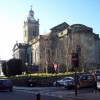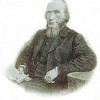In 1801 a young Episcopalian minister from Scotland was appointed Rector of Swanage on a stipend of £240 a year. He was the Reverend Andrew Bell, and his incumbency at this popular resort of the future was one of unprecedented philanthropy and innovation. As Rector of Swanage Bell energetically set up benefit societies, social clubs and even a small cottage industry for plaiting straw. He arranged for every child in his parish to be inoculated against smallpox, a great contagious scourge of the 19th century. And this minister had a considerable influence on the young John Mowlem, the master mason of Swanage and founder of the international construction company of that name.
But Andrew Bell will probably be remembered for one thing above all others: as the inventor of the method of elementary education known as the Madras System, after the state in India where it was conceived. The Madras System was a legacy of a past period of colonial servitude in Bell’s life, but by the time of his death it would be adopted across much of Britain. Several educationalists even sought Bell’s advice about how they could implement the system themselves, including Joseph Lancaster, an opportunist businessman and rival. Lancaster, however, infuriated Bell when the latter discovered that he was passing off the Madras System as his own conception. At one point Bell took two years leave of absence from the church to concentrate on disseminating his educational method more widely. Eventually he had 13 day schools and three Sunday schools using the system in Dorset, but would by no means neglect to further the provision of education in his Scottish home town.
Dr Bell would devote only about a decade of his life to the spiritual and material wants and needs of the Swanage people, yet he had no leanings towards an ecclesiastical career until he was 32. Before then he was something of a maverick, a speculator in New World cash-cropping, and while his life in holy orders was a resounding success the same would not be said for his business interests or his marriage, which ended acrimoniously in divorce after only six years.
But the single-mindedness so indicative of his character throughout his life doubtless showed itself early. Born in St. Andrews, Fife, on 27th of March 1753, Andrew Bell was the son of a barber/wigmaker-cum-horologist who in the latter capacity was responsible for regulating the clock of St. Andrews University and making scientific instruments for the physics (then National Philosophy) faculty. Andrew was first educated at the grammar school where mathematics was his greatest strength and languages his greatest weakness. However, during these early schooldays he was the subject of bullying from older boys, an experience that would instil in this future educationalist a lifelong abhorrence of corporal punishment. Bell’s proficiency in maths led him, at 16, to matriculation at the United College of St Salvatore & St Leonard’s in St. Andrews University. Here he studied for four years, but there is no evidence that he graduated at the end of this time. However, it was common in those days for graduates not to undertake a formal graduation ceremony.
So with his sound academic background Bell sailed from Glasgow in 1774 to take up a post as a tutor to tobacco plantation owners in Virginia, though not without “moonlighting” as a tobacco trader with a good sense of business. In 1779 Bell was engaged as tutor to the sons of a Virginia planter Carter Braxton, but with the colony in a politically unsettled state in the aftermath of the War of Independence Bell returned to Britain two years later with the Braxton Boys, so that their education could be finished. During the voyage however, their ship was grounded on an island near Nova Scotia by a storm for a time before they could be rescued, whereupon they eventually reached London in June. But Bell’s charges were not inclined to stay on the right side of the law, and after two years he returned to St Andrews to eke out a meagre living by running a small private school.
It was at this point that Bell considered studying for the priesthood, but with the Church of England, since he was an Episcopalian. His first living following ordination was at Leith Episcopalian Chapel under a one-year contract. The St Andrews MP, George Dempster, approached Bell with the proposition of a lecture tour to Calcutta teaching science. The newly-appointed minister duly accepted the offer and sailed for Calcutta in 1787, but stopped off on route at Madras. Here Bell decided to stay and give a brief course of lectures, but when appointed as Chaplain to four regiments, he decided to abandon going on to Calcutta.
In 1789 Bell was asked to take over running the Madras Male Orphan Asylum, an orphanage-school for the bastard sons of soldiers and native women. Struck by the great inadequacy of the teaching methods at the asylum, Bell was instead impressed by an open-air school where the pupils were being taught their letters by inscribing them in sand. But his employees, embittered by his forthright manner, were obstructive in Bell’s plans to improve the methods of education. Bell then introduced sand-trays into his school instead of books, but the move was not approved by the master and ushers either. In desperation Bell then instructed a boy called Jonnie Frisken in his lessons, teaching the eight year-old to teach even younger children. This led to the school being segregated into classes where boys could be masters, pupils and sometimes both, and Bell found that this way the children had no learning difficulties. But the school master and two ushers were so disgusted with the method that they left Bell to continue running a school going from strength to strength.
The Madras climate however, proved so indifferent to Bell’s health that in 1796, though much praised for his work, he returned to England. Here he immediately prepared a report on the asylum, then another report in the summer of the following year setting out the operation of the Madras System, i.e. in which all but the youngest children could hold pupil-teacher status. All lessons were taught and learnt by rote. A boy “master” teaching young children a lesson after learning it himself. The 1797 report was circulated to all important figures in the Church and Government. Child education would now be Bell’s consuming passion for the rest of his days.
Funded from his own pocket and with some outside support, Bell opened a few charity schools putting his system into use. It was then in 1801 he came to Swanage and as Rector involved himself in the parish and Sunday school (soon converted to the MS.) Soon Mrs Sarah Trimmer, a religious pamphlet writer, was writing to Bell desiring his opinion of Joseph Lancaster and at the same time extolling Bell’s system above that of his rival. She was convinced Lancaster had merely improved Bell’s system, while basically plagiarising it. Bell, after persistent entreaties from Sarah to come to London to organise a campaign against Lancaster and his method, eventually did so in 1807, staying there a month.
Once in the capital, Bell set up a charity school in Whitechapel with the assistance of two or those who had been involved in running the Swanage Sunday school. Realising it had become impossible to undertake his parochial duties at Swanage, Bell obtained a special licence from his Bishop in May1807 for two years leave of absence. As new schools were opened Lewis Warren, a teenage boy who had been assisting at the Swanage Sunday school, undertook their organisation in the West Midlands. On the expiry of the first two years Bell realised he would have to relinquish the Swanage living entirely.
In 1811 Bell was appointed advisor and sponsor for the newly formed Society for the Education of the Children of the Poor, and the Church versus non-denominational education schism came to public attention. Raised to a pitch of ire, Lancaster came out into the open and even declared in an article that he alone invented the Madras System, that all other claimants (presumably including Bell) were counterfeiters and impostors! The feud wasn’t to be defused until 1818, when Quaker friends sent Lancaster to America to disseminate the blunders of his system there. The organisers of his society then gave Bell the authority to travel the country as an inspector of his schools. He also travelled and lectured on the continent for some years, before ill-health forced his return to England.
On his return Bell retired to Cheltenham, where he revived his aim of furthering education in St Andrews. He acquired two properties in South Street for a school, and in 1831 established a fund of £120,000 to finance the building of a Grammar and English School. Under the terms of Bell’s will his estate at Egmore was left in the hands of Trustees who were supposed to set up another Madras School at Cupor, in Fife.
But the trustees, in defiance of his wishes, instead spent the money on projects to build an observatory, provide a dispensary and improve public water supply. Nor would the educationalist-cleric live to see his school finished. Dr Andrew Bell died on 27th of January 1832, just ten weeks before the foundation stone was laid, and was buried in Westminster Abbey.



